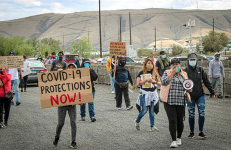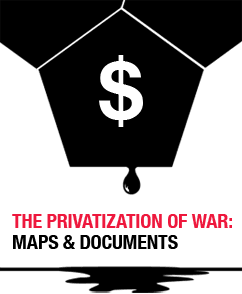The COVID-19 Pandemic and Class Struggle

Crises under capitalism tend to increase existing inequalities. This is also a consequence of the handling of the COVID-19 pandemic. Global labor income decreased by an estimated 10.7 % (or US$3.5 trillion) in the first nine months of 2020 compared to the previous year. Meanwhile, the total combined wealth of the more than 2,200 official billionaires worldwide grew from $9.5 trillion on December 31, 2019 to an estimated US$11.4 trillion a year later. Studies throughout the world confirm that poor and working-class people are at a higher risk of being infected and of being hospitalized due to COVID-19 and that Black, Indigenous, and racialized working-class populations experience disproportionate COVID-19 infection and death rates.
Struggles linked to the pandemic
Working-class people and communities rose up globally “because of” and “despite” the pandemic. Strikes and protests have been taking place in sectors that have been particularly impacted by increased operating pressure and risk of infection due to the pandemic, and that were already characterized by poor working conditions and low pay: healthcare and nursing, warehousing, mail-order businesses and logistics, passenger transportation, and food production, especially meat-processing and agriculture.
The healthcare sector, one of the main targets of neoliberal austerity policies for decades, has seen strikes all over the world, from the Americas and Europe to Asia and Africa. The workforce in this healthcare sector is mainly female; especially in the case of nurses, the low wages and high risk have a gender and racial dimension. Strikes have happened also in the public transport sector. Self-organized wildcat strikes by drivers took place in various US cities. In Brussels in May 2020, public transport workers staged a wildcat strike after the union reached an agreement with management without their consent. Workers in the metro systems in Mexico City, Medellín, and Santiago de Chile, and in the Japanese railways went on strike. In Germany, the trade union ver.di waged a series of strikes in urban public transport. Italy and Greece faced strikes across the public and private transport sector to secure job protection and increased salaries. Workers’ struggles in the food industry started in the meat processing sector in Western Europe and the US, where the workforce is predominantly migrant and infection rates were very high. In Italy, Spain, and the US, migrant agricultural workers went on strike. Strikes in the food retail sector in various countries followed. In the distribution and logistics sector strikes for increased protective measures were held in the early days of the pandemic from Australia to the US. In Italy all logistics companies and warehouses, including Amazon, TNT, DHL, and UPS, have experienced strikes and massive staff absences. Food delivery workers in Italy went on strike several times during the pandemic. A court forced the companies to hire all 60,000 workers delivering food by bicycle as dependent workers with benefits.
Struggles despite the pandemic
Strikes and workers’ struggles with no or only limited connection to the pandemic also took place. Labor conflicts gripped production plants where mass layoffs or even permanent closures were planned. In the Dutch IJmuiden steelworks, which is owned by the Indian Tata Steel, workers staged a strike lasting more than three weeks, thereby preventing the dismissal of 1,000 of the 9,000 workers and securing an employment guarantee until 2026. In India in December 2020, a mass strike took place in response to the government’s plans of massive deregulation of labor relations and the privatization of the huge public sectors. Some 250 million workers from the public and private sectors went on strike. Since September 2020, farmers in India have been protesting new laws favoring private investors and corporations. After the farmers stormed Delhi in January 2021, the government suspended the laws for 18 months. For the Prime Day bargain hunt in October 2020, Amazon workers in Germany, Spain, and Poland went on strike for better pay. A series of several-day strikes staged at Amazon sites across Germany followed. In the port of Bilbao, Basque Country, the 300 dockers of different companies went on strike for 55 days until the companies accepted several of their demands – including the limit of a maximum of 1,826 work hours per year, breaks at work, and holidays.
A variety of popular working-class revolts also happened or continued during the pandemic. The protests against the dictatorial coup regime in Bolivia forced new elections and brought back to power the MAS (Movement Toward Socialism) which had been ousted by the coup. In the US the main union AFL-CIO failed to respond adequately to the Black-led multiracial working-class revolt beginning in May 2020. However, in May and June alone, more than 600 work stoppages or strikes took place in solidarity with Black Lives Matter (BLM). Bus drivers refused to transport protesters to jail. The International Longshore and Warehouse Union (ILWU), which is 65% Black, shut down ports across the US Pacific Coast for almost nine minutes on June 9, 2020, the day of George Floyd’s funeral. On June 19, the holiday commemorating the end of slavery in the US, the ILWU went on a full eight-hour shift strike in all 29 West Coast ports. On July 20, unions and movements, including the ILWU, United Farm Workers, and the National Domestic Workers Alliance, partnered with BLM to organize the Strike for Black Lives in more than 25 cities.
New sites of labor action
Payday Report concludes that during the pandemic in 2020 the US saw its largest wave of strikes since 1946. According to the US Bureau of Labor Statistics, 2020 was – aside from 2009 – the year with the lowest number of industrial disputes. However, the latter counts only disputes involving 1,000 or more workers in one workplace, ignoring changes in the production structure. The new labor unrest is explicitly coming from the margins, from sectors unorganized before, from new unionizing, in working conditions that apply methods besides those considered as “industrial action.”
During the COVID-19 pandemic, as in previous years, workers’ struggles tended to start with self-organized struggles and unions with shop floor organizing. Struggles from the shop floor can respond faster and in more flexible ways. The traditional unions mostly avoided actively promoting strikes and when they were involved, it almost always occurred due to rank-and-file pressure. Neoliberalism and changes in production have significantly undermined the old models of organization, but new struggles and organizational structures are emerging globally. The weakness of the labor movement should still not be overlooked, however. In most contexts, the actions fall far short of what would be necessary to actually shift the balance of power in favor of labor. Nevertheless, workers’ mobilizations during the pandemic demonstrate that the assumption that class is no longer a relevant category is wrong. Moreover, the evident vulnerability of global supply chains increases again the structural power of workers in globalized manufacturing industries
Interrupting profits on a large scale remains the most powerful tool the working-class has. In this context the relationship between production and reproduction must be reconsidered, as should be the issue of class struggle and who wages it. Migrant workers make up a significant part of the new working-class in the capitalist centers. Gender and “race” neither replace class nor contradict it – they must be integrated into the analysis of capitalism and exploitation hierarchies. In her analysis of class struggles fought by women, Paola Varela makes a crucial observation: “the workplace is not taken as a sectorial space but as a powerful position […] that could serve as a catalyst and strengthen the claims of the working-class as a whole.”
Image: Farm workers in Yakima valley, USA on strike for better COVID-safe work environments in May 18, 2020. Credit: Facebook page Familias Unidas por La Justicia, Edgar Franks.
Links zu diesem Artikel:























